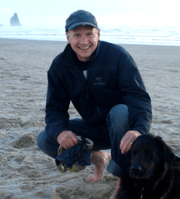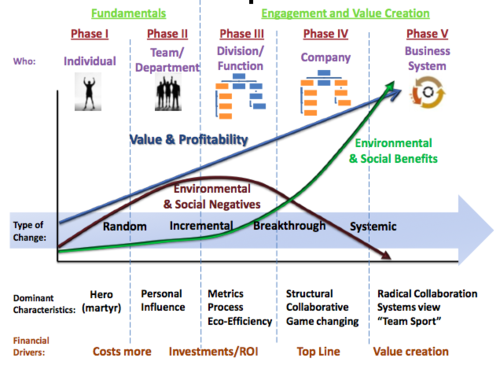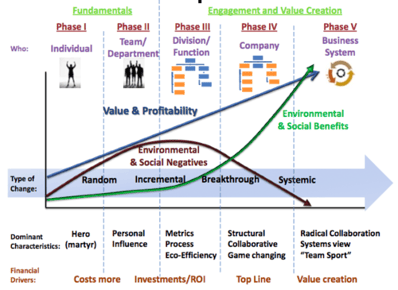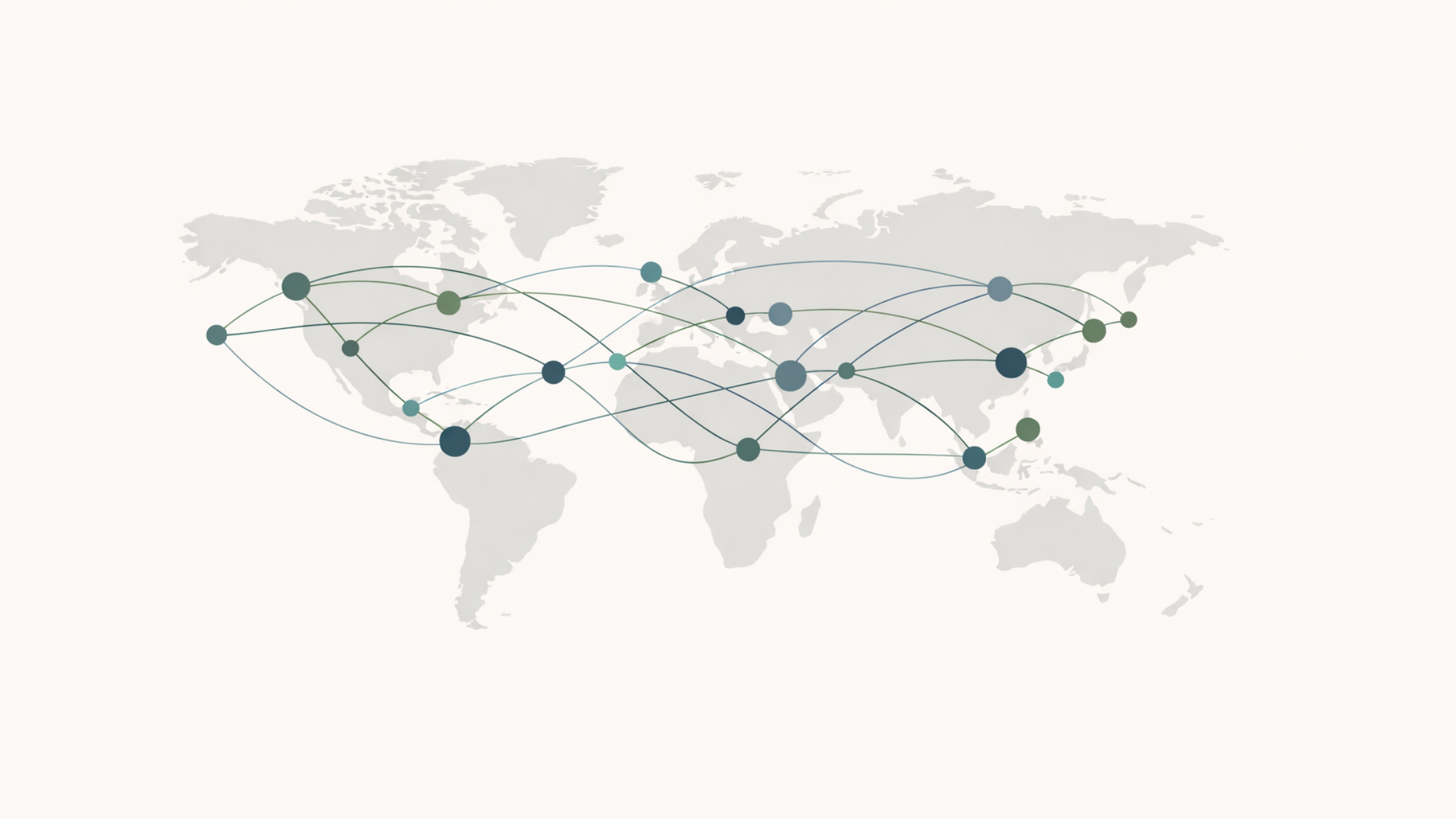By Guest Blogger, Kevin Hagen
This series has been taking a dive into the five phases of sustainable business described in the Hagen-Wilhelm change matrix published in Making Sustainability Stick. We want to offer a roadmap for those working to change business from inside large organizations. By capturing and sharing over a decade of experience implementing these ideas, hopefully we can help accelerate success. Earlier posts introduce the matrix and go deeper on Phase I, Phase II and Phase III.
Phase IV is getting to some rarified space. While there are groups or divisions within companies who are demonstrating phase IV behavior and results, there are few complete companies at this level. To get a sense of how many, I turned to CSRHub. This powerful on-line resource distills some 291 sources of data into a 100-point scoring system. Using CSRHub score as an indicator of where a company is on the change matrix can give an idea of the distribution of companies on the journey. Out of hundreds of thousands of companies worldwide, about 8,500 have been identified and analyzed for their sustainable business efforts. Fewer than 2000 score above a 56 and no company scores above an 80. That suggests that less than 1% of companies are possibly operating at stage IV. With so little real world experience it becomes clearer why there is little understanding of this definition of “sustainability”. It also says that companies just getting started are not too late.
An objective score is helpful, but it’s very difficult to use a single snapshot to understand where a company really is. Remember, companies are just collections of people, each one has to make their own shift to sustainable business thinking. So what are other indicators of Stage IV? One is when sustainable business skills, competencies and education are required to be successful at “ordinary” roles. At REI it was pretty much required to understand sustainable forestry and the FSC system in order to be a paper buyer. USGBC LEED accreditation was becoming a necessary credential to work in store development and real estate. Competency with the Sustainable Apparel Coalition’s HiGG Index and other Life Cycle Assessment tools was becoming required to be a Product Designer. And an understanding of social tools like those from the Fair Factories Clearinghouse is needed to be in sourcing.
Another indicator is to look at how “sustainability” projects are being managed. Is there a special project office running unique efforts, or are sustainable business criteria helping to drive priority and resources to projects across the organization. How about collaboration? Do good ideas have to climb a whole chain of command and then back down the other side in order to get permission to proceed, or are people at all hierarchy levels empowered to reach across silos to get things done?
More clues come from looking at business results. In stage IV negative environmental and social impacts (the brown line) are understood, measured and being aggressively addressed holistically. In fact, through game-changing innovations, negative impacts have been disconnected from company growth and are being reduced in absolute terms without unintended consequences. In other words, the brown line is going down while the business prospers. Beyond success at “doing less bad”, the company has started to identify ways in which it can use the power of enterprise to create value and measurably make things better. The Green Line is on the rise.
A good example happened at Gildan, a multibillion-dollar textile company based in Montreal, Canada. At first they successfully improved energy efficiency in their mills in Central America (less fuel, less pollution, less cost = less bad). Not satisfied, they radically redesigned the steam plant that runs their factory, switching from barges of imported bunker fuel oil to biofuels provided by local agricultural waste and secondary crops. They not only eliminated carbon emissions and eliminated a potential spill hazard; they broke their financial dependence on external fossil fuel and replaced it with a stable local energy supply that also provides an economic engine for their community. They used their business to create environment and social benefits while driving down operating costs and insulating themselves from risks. That’s an example of the green line rising – Stage IV results.
Keys to the game:
In previous articles I offered ways to anticipate what's coming and set the stage for successful next steps. The problem this time: No one has reached Stage V, so we're not sure what the keys to the game are. But I can offer an educated guess.
Radical Collaboration: As I talked about in an earlier article; Sustainability is a description of a system, not an individual entity or business. Without a forest eco-system not even a tree is sustainable. So in order for business to achieve sustainability we’ll have to do it together. The capabilities for business people to engage with organizations outside their four walls will be critical. While we’re used to working with customers and suppliers, the idea of radical collaboration is effective engagement with organizations in a more complex web - beyond buy/sell relationships. A great example is the Sustainable Apparel Coalition. This is a group of well over 100 Brands, factories, NGOs, academics and others working to make the textile industry more transparent, accountable and profitable by tackling social and environmental challenges. Learning the skills needed to be successful in these kinds of collaborations will certainly be a key in Phase V.
In the final post in the series, we’ll dive deeper into the illusive Phase V.
See Kevin's post introducing The Roadmap Series.
See The Roadmap Series: We all start at Stage I
See The Roadmap Series Phase II: The First Big Step
See The Roadmap Series, Phase III: From Personality to Process
 Kevin Hagen is a sustainable business advocate. For over a decade he has helped business be more successful by making the shift to more sustainable thinking. As a leader inside medium to large companies or as an external advisor Kevin helped design and implement successful sustainability strategies and programs. Most recently, Kevin lead Corporate Social Responsibility (CSR) strategy and implementation at REI, a leading outdoor retailer and the U.S.'s largest consumer co-op. Kevin's team delivered great results, received a lot of recognition and showed that a mission based company with nearly $2B in sales can reduce it's environmental footprint while growing profitably. See Kevin's blog where he shares ideas, news and offer resources and organizations that he thinks can help companies make progress toward sustainability while delivering bottom line benefits at the same time.
Kevin Hagen is a sustainable business advocate. For over a decade he has helped business be more successful by making the shift to more sustainable thinking. As a leader inside medium to large companies or as an external advisor Kevin helped design and implement successful sustainability strategies and programs. Most recently, Kevin lead Corporate Social Responsibility (CSR) strategy and implementation at REI, a leading outdoor retailer and the U.S.'s largest consumer co-op. Kevin's team delivered great results, received a lot of recognition and showed that a mission based company with nearly $2B in sales can reduce it's environmental footprint while growing profitably. See Kevin's blog where he shares ideas, news and offer resources and organizations that he thinks can help companies make progress toward sustainability while delivering bottom line benefits at the same time.



.png)
